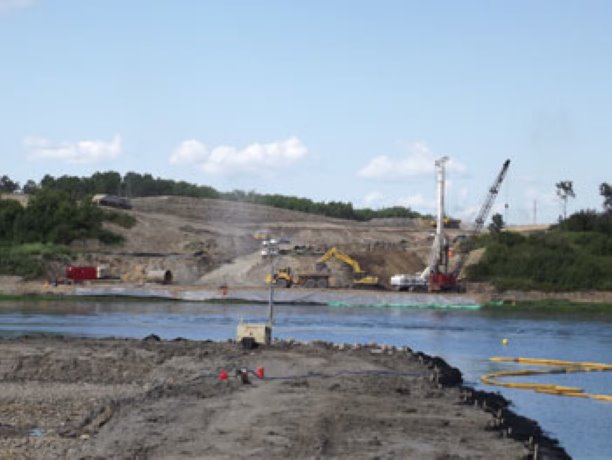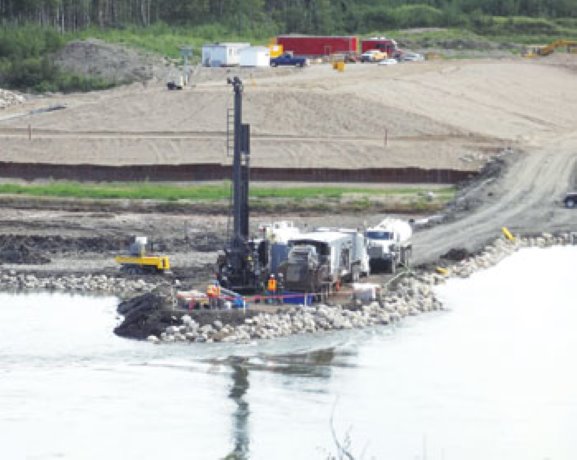Nearly 100 years after the bridge in St. Louis, Saskatchewan, was erected by the Grand Truck Pacific Railway, the town and province is getting a new one.
Nearly 100 years after the bridge in St. Louis, Saskatchewan, was erected by the Grand Truck Pacific Railway, the town and province is getting a new one.
Building the new $30 million bridge, however, requires some fancy footwork.
The 380-metre steel bridge spanning the South Saskatchewan River close to the small town of 481 residents, will sit directly atop the Hatfield Valley Aquifer, a high-pressure, confined aquifer about 22 metres thick.
Piercing the aquifer or even shifting enough weight off of it in any one place could cause it to rupture, swamping the project site.
Therefore, instead of simply driving piles deep into the ground, the Saskatchewan Ministry of Highways and Infrastructure, and Graham Construction, have taken a series of precautions to avoid aquifer blow-outs, while proceeding with a spread-footing design to support the highway bridge.
The wide, shallow, reinforced-concrete slab footing is ideal for South Saskatchewan River and Hatfield Valley foundation.
Building atop the aquifer is definitely the project’s biggest challenge said Jeff Nelson, senior bridge manager with Genivar, the consulting engineering and supervision firm on the project.
“We’ve had to drill a series of relief wells and back-up relief wells and put pumps on them to get a little local draw-down on the aquifer because there was some concern about ‘basal uplift’,” he said.
“We’re making sure we don’t do anything to risk a blow-out when they’re excavating the bottom of the footing.”
Basal uplift can occur once the weight of all of the water and soil has been excavated from on top of an aquifer.
Once the pressure that had been keeping the aquifer contained has been relieved, the pressure in the aquifer could burst.
Nelson said that even though the soil at the site is hard and competent, it is made up of over-consolidated silt that could wash away if piles were driven in.
This could lead to pressure being released from the aquifer.
Geological research into building a new bridge began in 1997, and final bridge location and route selection was completed in 1999.
But, overcoming the challenges of building over the Hatfield Valley Aquifer actually took a decade.
Doug Hansen with the Saskatchewan Ministry of Highways and Infrastructure, Northern Region, said the aquifer is nearly 30 kilometres wide, so it can’t actually be avoided.
“In this case, there are very significant underground issues at play,” he said.
“As an example, the water pressure is about five metres higher than the water elevation in the river, so it was a key issue in determining where the bridge was going to be located.”
Ultimately the new site, 1.6 kilometres from St. Louis, was chosen for its relatively favourable underground conditions, as well as that the crossing will allow straight alignment with northbound Highway 2.
The present roadway follows a series of winding turns into the town.
Connecting the north section of Highway 2 with the south will complete a 683 km stretch of primary-weight highway between the U.S. border and Prince Albert, Sask.
The roadway on the present bridge, opened to vehicle traffic in 1929, is weight-restricted, and therefore off-limits to trucking.
Trucks are rerouted.
“The other issue was the type of foundation we used on the bridge. We went with what we call a spread-footing foundation, as opposed to piles,” Hansen said.
“We also had to be very careful about how we put in those footings. If we took too much material off that pressurized aquifer, it blows up on you.”
Another issue, of historical significance, was the discovery of 7,900-year-old buffalo bones at the excavation site of the project’s south abutment.
A 2002 Heritage Resources Impact Assessment found the site had been occupied for more than 3,000 years and contained a bear tooth, as well as the bones and skull of the Bison Antiquus.
All heritage concerns have since been mitigated.
The new St. Louis bridge is expected to open in fall 2012.
The south abutment was completed in winter 2011, and the north abutment is three-quarters finished.
Vulnerable to active landslide slip planes, the north abutment had to be stabilized with 148 rock columns — two metre wide holes filled with crushed bedrock.
Three piers will be installed into the river by fall 2012, while the bridge’s steel superstructure will be lifted off the ice in January 2012.
Three tenders will come out for roadwork this fall—two for earthworks projects and the third for the road surfacing contract, and the alignment will feature a road width of 11.4 metres.

bridge over the Saskatchewan River











Recent Comments
comments for this post are closed